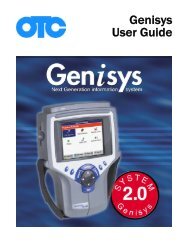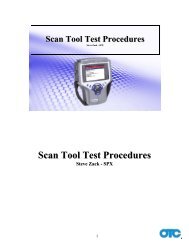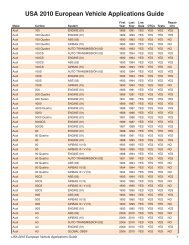ABS / AIR BAG 2004 USER GUIDE - OTC
ABS / AIR BAG 2004 USER GUIDE - OTC
ABS / AIR BAG 2004 USER GUIDE - OTC
You also want an ePaper? Increase the reach of your titles
YUMPU automatically turns print PDFs into web optimized ePapers that Google loves.
Safety Precautions<br />
Danger:<br />
<strong>ABS</strong> / Air Bag <strong>2004</strong> User Guide<br />
Safety Precautions<br />
• When an engine is operating, keep the service area WELL VENTILATED or attach a building<br />
exhaust removal system to the engine exhaust system. Engines produce carbon monoxide,<br />
an odorless, poisonous gas that causes slower reaction time and can lead to serious injury<br />
or death.<br />
Warning:<br />
When working with hydraulic or fuel lines, liquids under pressure may escape and create a<br />
dangerous condition. Never open a bleeder valve or loosen a hydraulic line while the <strong>ABS</strong><br />
is pressurized. Use adequate ventilation and make sure there are no sparks or possibility of<br />
sparks present that may ignite any vapor.<br />
Wear an American National Standards Institute (ANSI) approved eye shield when testing or<br />
repairing vehicles. Objects propelled by whirling engine components or pressurized liquids<br />
escaping may cause personal injury.<br />
Set the parking brake and block the wheels before testing or repairing a vehicle. It is especially<br />
important to block the wheels on front-wheel drive vehicles because the parking brake does<br />
not hold the drive wheels.<br />
Do not drive the vehicle and operate the NGIS tool at the same time. Any distractions may<br />
cause an accident. Have one person operate the NGIS tool as another person drives the vehicle.<br />
Maintain adequate clearance around moving components or belts during testing. Moving<br />
components and belts can catch loose clothing, body parts, or test equipment and cause<br />
serious damage or personal injury.<br />
Automotive batteries contain sulfuric acid and produce explosive gases that can result in<br />
serious injury. To prevent ignition of gases, keep lighted cigarettes, sparks, flames, and other<br />
ignition sources away from the battery at all times. If you are using the battery as a power<br />
source, connect the RED (+) battery clip to the positive vehicle battery terminal and connect<br />
the BLACK (-) battery clip to a good ground away from the battery.<br />
Refer to the service manual for the vehicle being serviced and adhere to all diagnostic<br />
procedures and precautions. Failure to do so could result in air bag deployment, personal<br />
injury, or otherwise unneeded air bag system repairs.<br />
Only use specially designed replacement parts (brake hoses and lines) for <strong>ABS</strong>-equipped<br />
vehicles.<br />
After bleeding the brake system, check the brake pedal for excessive travel or a “spongy”<br />
feel. Bleed again if either condition is present.<br />
When installing transmitting devices (Citizen Band radio, telephone, etc.) on <strong>ABS</strong>-equipped<br />
vehicles, do not locate the antenna near the <strong>ABS</strong> control unit or any other control unit.






